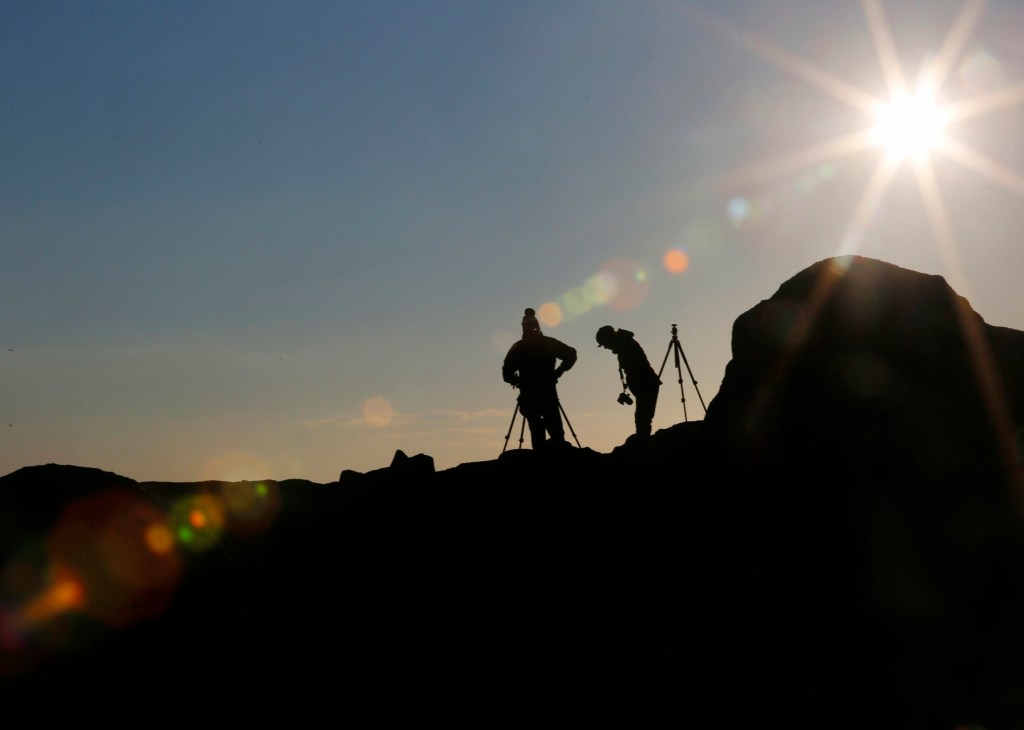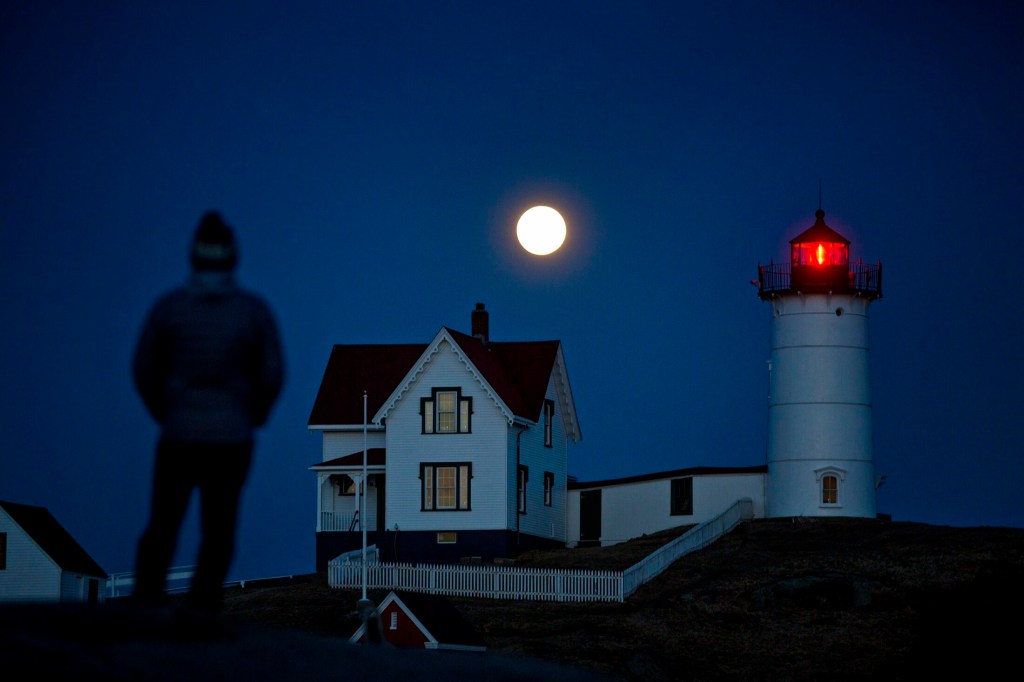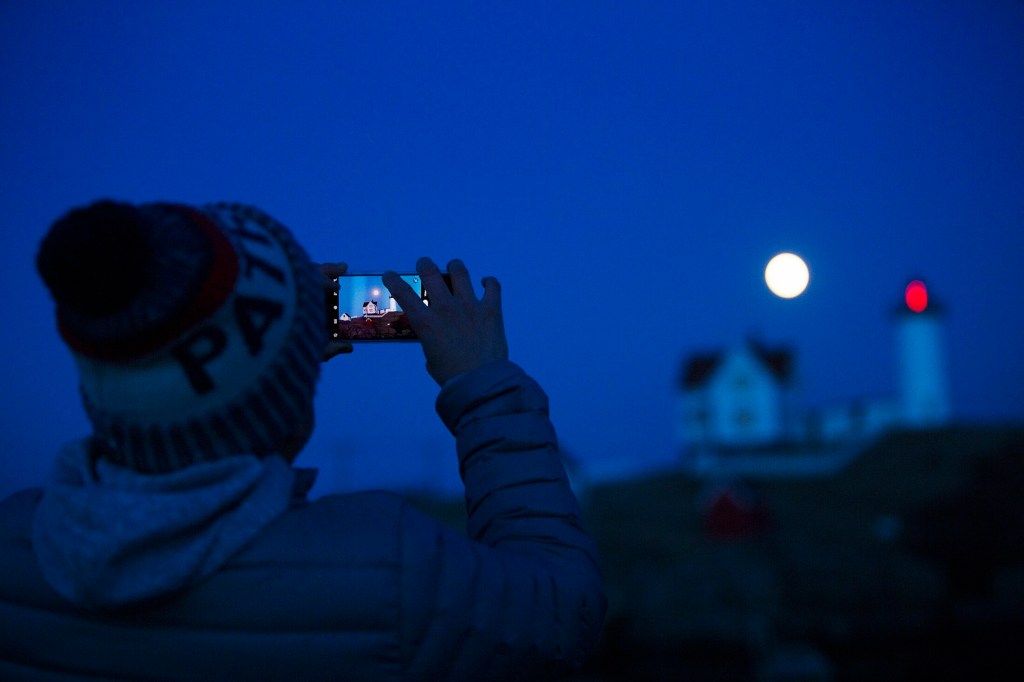YORK — Matt Rosenberg called to Scott Sherman as the two strangers leaned over tripods on the rocks below Nubble Light to ask Sherman the name of his Instagram account. In the enveloping darkness after sunset as the other photographer answered, Rosenberg broke into a grin.
“After you’ve been following someone’s work on Instagram for years, it’s fun to finally meet them in person here,” said Rosenberg, of Wells, in reference to the other photographer, who is from Stratham, New Hampshire.
“Here” is the full-moon gathering at Nubble Light. The coming together of photographers at the picture-postcard scene when the moon is full and the sky is clear has become a wintertime event that draws anywhere from a dozen to more than 100 photographers. Professionals and hobbyists alike line Long Sands Beach in York directly across the water from the 140-year-old red-and-white lighthouse, or cluster on the rocks below to shoot up at the lighthouse. The age range can span 20 to 70 on any given night. Photographers come from around northern New England, but sometimes from as far as New York.
The large gatherings have become as predictable as the full moon. What is less obvious is that photographers come, time and again, not only for the opportunity to photograph an iconic Maine view in the fading light, but to be in the company of like-minded artists who share the quest of photographing a much-photographed lighthouse in a new and fresh way. Some say it’s actually not that hard.
“I think what draws people to photograph something that’s been shot over 1,000 times by everyone is that it’s such a picturesque site. It lends itself to different feels each time, it’s a different experience depending on the weather. I was here at 3 a.m. in super storm (Sandy in 2012) and when the (dawn) light hit it, it was beautiful,” said Peter Hurt of North Hampton, New Hampshire, a hobbyist who sells his landscape images on the side.
“What draws people is we have this common bond – talking shutter speed, aperture. And Nubble is unique and is picturesque.”
During the last full moon, on March 20, Hurt stood back from the crowd as the sun set and smiled with enjoyment as though it were his first time at the beacon. In fact, he has come for this event as many as 40 times. “I’m kind of like a regular here,” he said.
If it’s foggy or the moon is hidden behind clouds, the gathering may not happen. But otherwise when the full moon rises in the winter, Sohier Park next to the York lighthouse attracts a swarm of photographers. The view can be scenic in the summer, too, but the dynamic changes. “In the summer, it’s more tourists. In the winter, the colder months, it’s usually just the photographers,” Rosenberg said.
March 20 brought a super moon, meaning the moon was the closest it can get to Earth during its 27-day orbit at the same time that it was full. Such moons appear larger than usual to onlookers. Because the moon’s orbit changes, the super moon occurs just a few times a year. About 20 photographers gathered, each standing 2-3 feet away from the next. None seemed to mind the fact that with temperatures around 30 degrees, the ocean gusts were biting. For 45 minutes after the sun set, they photographed the moon from various vantage points, as it rose behind and then over the lighthouse. The time constraints seemed to add to the excitement.
Jason DeHoyos came from Nashua, New Hampshire; it was his first time, and he was giddy. He learned about the full-moon event on another photographer’s Facebook page in February and then researched the moon’s phases. As he gingerly made his way along the rocks at Sohier Park, it wasn’t long before he was enshrouded in darkness. With each step, he looked through his camera to see if he yet had the shot he wanted. He’d positioned a second camera on a small tripod on his van to capture time-lapse photos. He didn’t quite get the exact shot he wanted, with the moon rising between the caretakers’ house and the beacon. It didn’t matter.
“I saw photos from February, and it was amazing,” DeHoyos said. “I will definitely be back.”
As Dana Littlefield, 72, made his way carefully in the dark over rounded boulders, a place where it would be easy to turn an ankle, he held fast to his camera and tripod as he inched toward the ocean. There, four other photographers standing behind their respective tripods greeted him. After hiking with his grandson that morning, he said his septuagenarian knees were sore. But like DeHoyos, Littlefield was determined to capture the exact image he sought. It was only his fourth time to the Nubble full-moon event, and his first this year. He also intends to return.
“I don’t have the right lens,” Littlefield said, but continued shooting with a smile.
Beside him, Rosenberg took it all in. The cluster of photographers in the dark and the beacon lighting up the sky was a familiar scene to him. Rosenberg teaches English at nearby York High School and is a hobby photographer and lighthouse keeper at Nubble Light in the summer.
When another photographer walking through the group sounded confused, Rosenberg smiled and offered some inside information.
“I’ll give you a tip,” Rosenberg said. “The (beacon’s) light goes off four times, and the first time is the brightest. So if you time it for after that, you won’t get that bright spotlight.”
Deirdre Fleming can be reached at 791-6452 or:
dfleming@pressherald.com
Twitter: FlemingPph
Send questions/comments to the editors.







